Art & Exhibitions
Oh Yes, Brooklyn Gallerists You Need to Know, Part 1
Here are the dealers shaping the Brooklyn art scene.
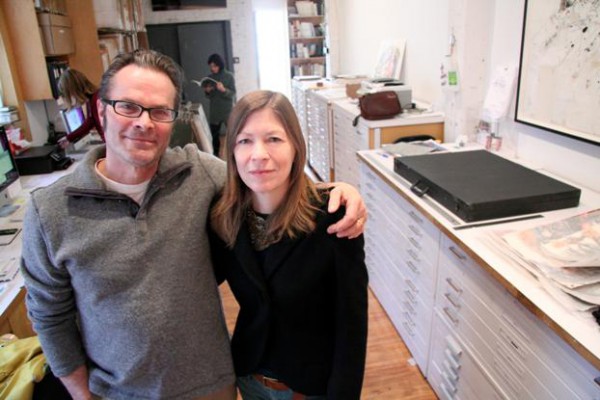
Here are the dealers shaping the Brooklyn art scene.

Benjamin Sutton

Over the past decade the Brooklyn gallery scene has reached a marker of maturity: Instead of aspiring to make the move to Manhattan, dealers are staying put, taking advantage of their borough’s unique combination of (relatively) affordable rents and a dense concentration of artists to foster a vibrant and self-contained gallery system centered around the northern neighborhood of Bushwick. As this outlying zone of the New York art world gains prominence and draws more and more Manhattan collectors and curators across the East River, its dealers are increasingly playing a role in shaping the city’s contemporary art discourse—and market. These are some of the key players in this rich and varied gallery ecosystem.
On February 28, many of the dealers featured below will be participating in the biannual 10th Bushwick Beat Nite, when most of the neighborhood’s galleries stay open late with exhibition openings, performances, and the like. In case you can’t make it out, keep your eyes peeled for these dealers during Armory Week (March 6–9), as many of them will have booths at one or more of the week’s art fairs.
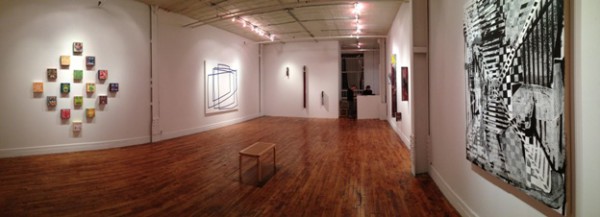
THEODORE:Art installation view.
Photo: Paul D’Agostino.
Stephanie Theodore, founder, owner, and director of THEODORE:Art.
What is a recurring or common motif, theme, interest or formal tendency that you would say characterizes your gallery program and makes it stand out?
I am interested in art that has immediate visual appeal but reveals nuance and subtext over time with repeated viewings, the kind of art that is analogous to a song that you hear once, and can’t get out of your head weeks, months, or years later. Many layers, much thought, loaded with intent, and yet still “looks like art.” This takes a certain maturity and insight on the part of the artist. I tend to work with artists not fresh out of school. I work with artists who are experienced, educated, smart; who know what they create and why they make it, and how it reflects their interests and engagement in the larger world.
I suppose I do show a lot of painting. But I don’t consider the gallery a “painting” gallery.
What are the greatest advantages to running a gallery in Brooklyn, as opposed to in Manhattan?
Economic sustainability—the rent is significantly cheaper, which means I can put on exhibitions that may not appeal to buyers. I don’t worry so much about getting crowds of casual visitors. Bushwick is an art enthusiast’s destination—people come determined to see as much as possible.
But what I found out after moving in is the fantastic, inclusive, heterogeneous community that supports almost every kind of effort to support art and struggling artists. Yes, we are all striving for another review, another sale, another visit from a museum curator . . . but there is so much more cooperation among gallerists and directors of alternative spaces and artists. We are all after recognition of the community and the individuals, and everyone understands that the two go hand-in-hand.
What are the greatest challenges to running a gallery in Brooklyn?
Getting Manhattan-centric art lovers to change their habits. Getting critics to make regular rounds. The inevitable gentrification of the neighborhood into something resembling present day Bedford Avenue, which means the end of our little boho-ville and the end of experimentation. But that’s a few years off. Carpe diem.
Can you recommend a nearby restaurant or bar where someone coming to visit your gallery should go for a post-art meal or drink?
Absolutely. Momo Sushi Shack for some of the finest sushi and Japanese-inflected food ever, and it’s very hospitable to vegans and omnivores alike. Don’t miss the party bomb platter or the unfiltered sake, and say hello to Phil.
For drinks – Alaska. A big comfortable, dark, dive-y joint with booths, sofas, tables, and a cozy long bar. I like the $5 boilermakers for after openings, other friends like the vast selection of bourbon, and everyone loves the crazy video and the ever-awesome music. Just don’t attempt to order wine. It’s not that kind of place.
Currently at THEODORE:Art: Christopher Moss’s “King for a Day,” through March 20.

The entrance to Interstate.
Photo: Courtesy of Interstate.
Tom Weinrich, owner and director, Jamie Sterns, partner and director, Interstate.
What is a recurring or common motif, theme, interest or formal tendency that you would say characterizes your gallery program and makes it stand out?
We work with artists who are experimental in both the mediums and processes they work with and also their conceptual focuses. Because of the size and layout of the space, we are able to give a larger context and venue for younger artists who may not usually be able to realize a project at a certain scale early on in their practice. We want artists to take risks and to create their “dream” show without any other motivation than to actualize their work. There is also a tendency for narrative-based works. Either directly with language/writing as a primary or secondary source or with storytelling.
What are the greatest advantages to running a gallery in Brooklyn, as opposed to Manhattan?
Being able to have a large space. Having a comparable sized space in Manhattan, at our current status, would be impossible.
What are the greatest challenges to running a gallery in Brooklyn?
Collectors and press tend not to venture out as much. It’s definitely a planned afternoon visit.
Can you recommend a nearby restaurant or bar where someone coming to visit your gallery should go for a post-art meal or drink?
Alaska is great for drinks and it’s only two blocks away.
Currently at Interstate: Jeff Baij’s “Yautja Moms,” and Melissa Sachs and Cameron Soren’s “Freelance Hellraiser (Studio Visit),” both through March 23.
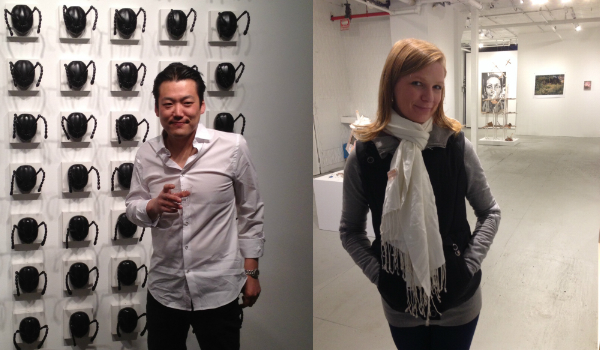
Nao Matsumoto (left) and Lori Kirkbride (right), of Lorimoto.
Photo: Courtesy of Lorimoto.
Lori Kirkbride and Nao Matsumoto, co-owners and directors of Lorimoto.
What is a recurring or common motif, theme, interest or formal tendency that you would say characterizes your gallery program and makes it stand out?
Lori Kirkbride: I would say that we don’t want to be too tied to a particular corner. Right now we are focusing on organized group shows around a central theme that includes work from various media as well as 2-D and 3-D work, trying to create a well-rounded exhibition. As far as formal elements or tendencies, I think we (as artists) both care about or are attracted to the same things that are important to us in our own work. We enjoy work that employs humor, is clean (and by clean I mean NOT messy), very well crafted and can be presented in a professional manner. We are also planning shows that will overlap other creative fields such as design and furniture.
We sort of feel like a lot of artists get shown over and over in the Bushwick/Ridgewood circuit. We are trying to show a broader range of artists, and while many are Brooklyn artists, we hope to introduce you to some you may have not heard of yet as well, as some icons along the way.
What are the greatest advantages to running a gallery in Brooklyn, as opposed to Manhattan?
LK: Well, I’d say that I don’t really know, considering Lorimoto is technically in Ridgewood, but for us I think it’s that we can experiment so much more. When you start an artist-run gallery (as many Bushwick/Ridgewood galleries are) in Brooklyn or Queens, it’s a delicate balance between time devoted to organizing shows and creating your own work. Here we are able to have both of our art studios in the same building and we also live upstairs. This gives us no commute and gives us more time to work on our own art. I don’t think that this is something we would ever find or be able to afford in Manhattan. Also we are where artists and many galleries are, so it’s very easy to see shows and studios. This also makes picking up and dropping off work pretty easy. We love the vibe and acceptance of the community and that Bushwick and Ridgewood galleries work together promoting each other and creating events.
What are the greatest challenges to running a gallery in Brooklyn?
LK: For us I would say getting the foot traffic after the openings. We are a stand-alone space on a residential block so we don’t get the same traffic as the gallery buildings do. During warm weather we had a lot more traffic because we are on the ground floor and could have our doors open to the sidewalk. Since winter it’s been harder to get people out during our weekend hours.
Can you recommend a nearby restaurant or bar where someone coming to visit your gallery should go for a post-art meal or drink?
LK: We have all of our after-parties at Houdini Kitchen Laboratory (1563 Decatur Street). Wood-fired oven pizza and salads, homemade burrata and more. Think Roberta’s before, well, it became so Roberta’s. It’s located on the ground floor of an old brewery building and come summer they have this lovely back porch, garden outdoor area. As of today they have no liquor license, so it’s BYOB, which makes it way affordable. We take over our leftover beer after an opening or there is a liquor store and a bodega on the way.
Currently at Lorimoto: “Rubberneck,” featuring works by Caroline Larsen, David Livingston, and Kenjiro Kitade. Through March 23.
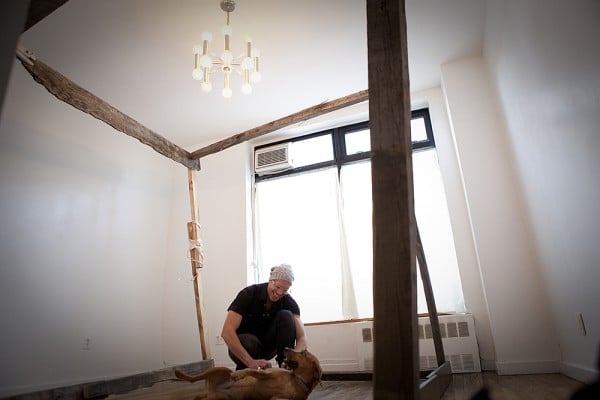
Jason Andrew with his dog Fern at Norte Maar, with installation by Anthony Browne.
Photo: Courtesy of Norte Maar.
Jason Andrew, co-founder and director of Norte Maar, co-owner of Outlet.
What is a recurring or common motif, theme, interest or formal tendency that you would say characterizes your galleries’ programs and makes them stand out?
Well, if there is any recurring or common theme it has to be quality over quantity, accessibility over inaccessibility. As with each project developed and presented and promoted by myself it is vital to retain a high level of quality while remaining open to the ideas of my artists or collaborators. My DYI attitude is certainly a thread throughout both my presenting organization Norte Maar and the public gallery Outlet Fine Art.
What are the greatest advantages of running a gallery in Brooklyn, as opposed to Manhattan?
The greatest advantage was once that Brooklyn was more or less cut off from critics and the societal mainstream. This offered a free forum for ideas and creative spontaneity. Now, Brooklyn is more than ever the center of the New York art and fashion world and this threatens the stability of the artists, with whom I’ve always been closely aligned. For many it’s a daily struggle to juggle rent and studio space. This in turn drastically affects their ideas and creative spontaneity. But they continue to make it work, and as they do, I continue to find new avenues to promote and present their work.
What are the greatest challenges of running a gallery in Brooklyn?
The greatest challenge in running a gallery anywhere is gaining the trust, respect and confidence of collectors. I continue to inspire those raw collectors who, as Holland Cotter put it, have the guts, the eye and the interest to “venture far from blue-chip boilerplate” collecting. Beyond this, and even more important to me, is the daily challenge to remain open to ideas and creative spontaneity.
Can you recommend a nearby restaurant or bar where someone coming to visit your gallery should go for a post-art meal or drink?
Bushwick is full of fabulous bars. Call me old fashioned, but I like supporting those that have been supporting the art community. Bodega and Heavy Woods are certainly the tops of my list and both are just blocks from Norte Maar. Lately Miles has been our regular post-opening spot to hang. Great drinks and fine foods.
Currently at Norte Maar: The 10th Bushwick Beat Nite, which Andrew is instrumental in organizing—and this time around is curated by artist and Pocket Utopia gallerist Austin Thomas—takes place February 28.
Currently at Outlet: “Azettagh,” featuring works by Samantha Bittman, Rachel Hayes, Brece Honeycutt, and Robin Kang, through March 2.

Joe Amrhein and Susan Swenson of Pierogi.
Photo: Courtesy of Pierogi.
Joe Amrhein, founder, co-owner, and co-director, and Susan Swenson, co-owner and co-director of Pierogi.
What is a recurring or common motif, theme, interest or formal tendency that you would say characterizes your gallery program and makes it stand out?
Pierogi features contemporary, process-oriented work with conceptual content by emerging and established artists working in all media. Also key to the gallery is an ever-changing and eclectic selection of works on paper by more than 800 artists in Pierogi’s iconic flat files.
What are the greatest advantages to running a gallery in Brooklyn, as opposed to Manhattan?
Brooklyn has an international cachet and has many neighborhoods which are still dynamic artist communities, despite the gentrification which has affected much of New York City in recent years. It retains the feeling of community that drew us here to begin with. We also try to stay away from this comparison because everything is so close once you understand the dynamics of the five boroughs, not only Manhattan and Brooklyn—maybe that’s the reality of doing business outside of Manhattan. Also, we don’t want to marginalize anything by making those comparisons.
What are the greatest challenges to running a gallery in Brooklyn?
You have to develop yourself as a destination, since Chelsea and the Lower East Side have a greater density of galleries.
Can you recommend a nearby restaurant or bar where someone coming to visit your gallery should go for a post-art meal or drink?
Hotel Delmano (not a hotel) is a great place to get a drink nearby. There are more restaurants opening in the neighborhood than we can keep up with but Cafe Collette is just a block and a half from us and has terrific food and drink. Marlow & Sons is not the closest or the newest but remains one of our favorites and always has tasty food and spirits. The Gutter is a directly across the street from the Boiler and has a low-key bar and vintage boiling lanes for those so inclined. A relatively new roof-top hangout sits atop the Wythe Hotel a few blocks away, which also has a great restaurant, Reynard.
Currently at Pierogi: “Idiom II,” featuring works by Justin Amrhein, Beth Campbell, Jonathan Herder, Mark Lombardi, William Powhida, and Ward Shelley. Through March 16. And Ward Shelley and Alex Schweder’s project “In Orbit” at Pierogi’s project space, the Boiler, February 28–April 5.
Armory Week Plans: Pierogi will be showing works by gallery artists at the Armory Show in booth 752 on Pier 94.
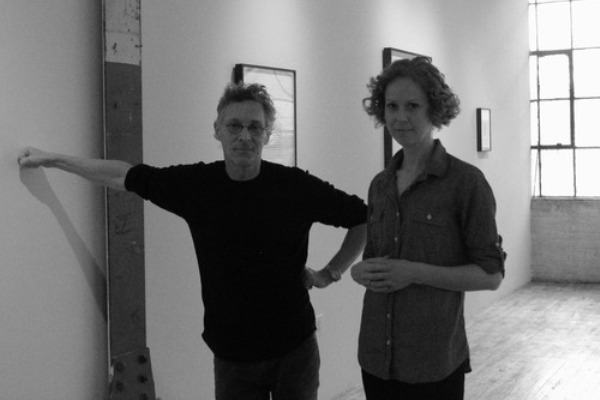
Lawrence Greenberg and Annelie McGavin at Studio 10.
Photo: Sean Alday.
Lawrence Greenberg, owner, and Annelie McGavin, director, at Studio 10.
What is a recurring or common motif, theme, interest or formal tendency that you would say characterizes your gallery program and makes it stand out?
Annelie McGavin: A light-handed aesthetic is often a formal tendency that Larry and I gravitate towards when looking at work of any kind. Within a broad range of programming, Larry and I have developed an interest in Sound and Noise. Several of our solo exhibitions have been with artists using sound like Richard Garet, David Schafer, David Henderson and Douglas Henderson. Our first exhibition was with Perry Bard’s video installation of “Man With A Movie Camera: The Global Remake.” Video and new media have remained tenets of the gallery program.
We appreciate a collaborative exchange with artists exhibiting with us. Preparations for exhibitions are shared between me, Larry, Becky and, the artist from the first studio visit until the deinstallation. The artists and those of other professions who supported us are integral to our identity and so is being in Bushwick.
We have a regular schedule of events and performances that happen in addition to monthly exhibitions. We share an interest in other disciplines such as literature. e.g. Matt Freedman’s graphic journal Relatively Indolent but Relentless published by Seven Stories Press formed the basis of an exhibition at Studio 10. Bimonthly poetry readings organized by Jason Koo of the Brooklyn Poets are held at Studio 10. Artist talks are held with most exhibitions to provide a place for the artist to engage with peers and the public.
The Bushwick Soapbox is organized by Jen Dalton, Bill Powhida, and Adam Simon. The event follows the 19th-century tradition in Hyde Park, London, and Union Square in New York City. Adam Simon has the current exhibition titled “Swipe” at Studio 10.
What are the greatest advantages to running a gallery in Brooklyn, as opposed to Manhattan?
AM: Proximity to artists and galleries and writers is very beneficial. I can live very close to where I work. We are also an alternative to Chelsea. Our identity is set apart from Manhattan. Shared synergy with other galleries in Bushwick allows for cross-pollination of ideas.
What are the greatest challenges to running a gallery in Brooklyn?
AM: One challenge is visibility. We aim to build a collector base that can ultimately support artists and their studio practices. We have chosen to participate in VOLTA NY with Meg Hitchcock this year to broaden our platform and reach audiences from other cities.
Can you recommend a nearby restaurant or bar where someone coming to visit your gallery should go for a post-art meal or drink?
AM: I really do love Shinobi for ramen. They are the best (but only open for dinner). If visiting earlier in the day, Café Ghia has a great brunch. Post–art openings, the Narrows is a good place to wind down with a Sol and lime or a patty melt in the back garden.
Currently at Studio 10: Adam Simon’s “Swipe,” through March 2.
Armory Week Plans: Studio 10 will be showing works by Meg Hitchcock in their booth at VOLTA NY.
STAY TUNED FOR PART 2 OF OUR BROOKLYN DEALERS POWER LIST.